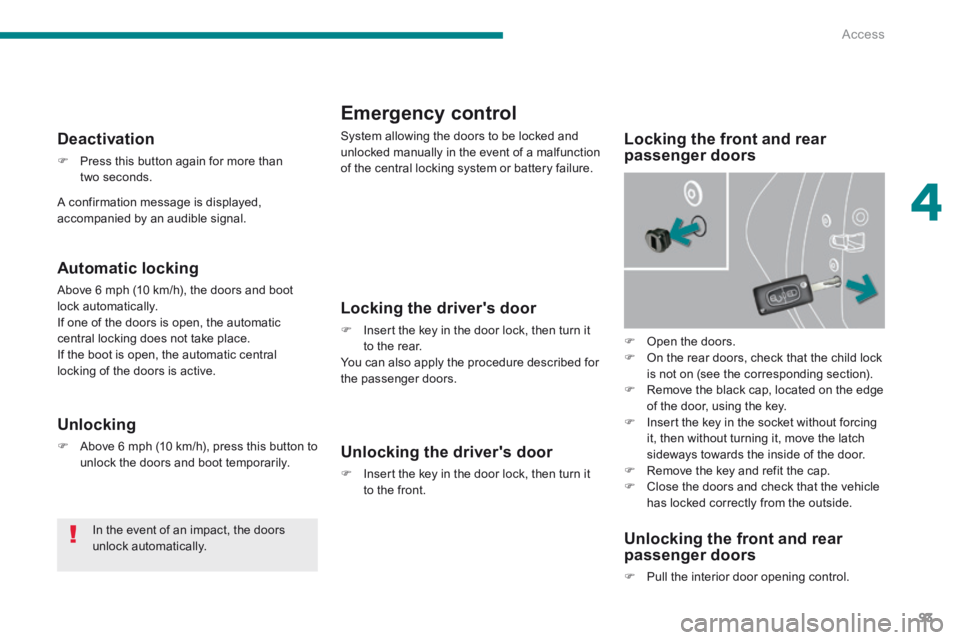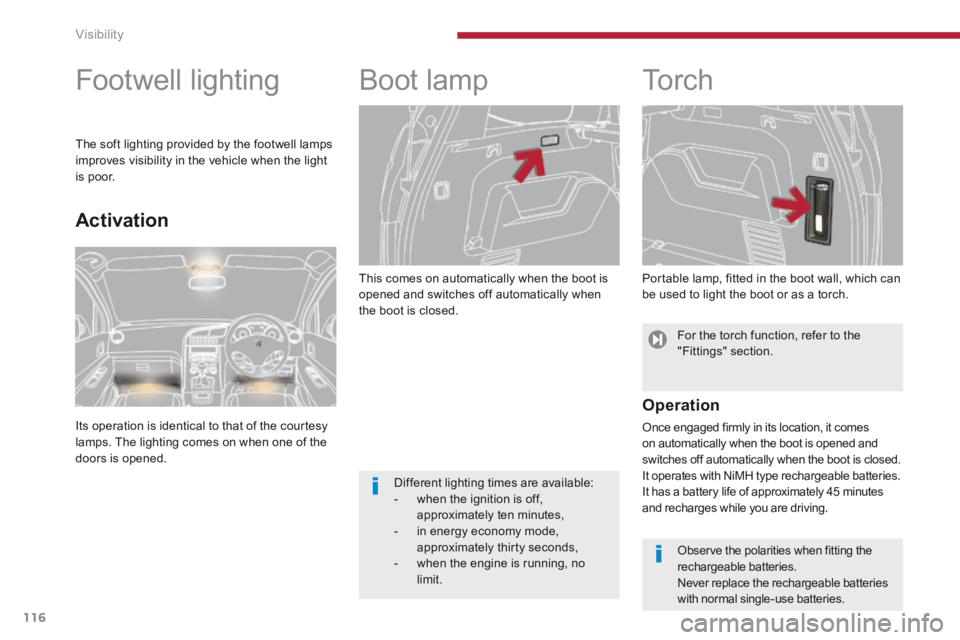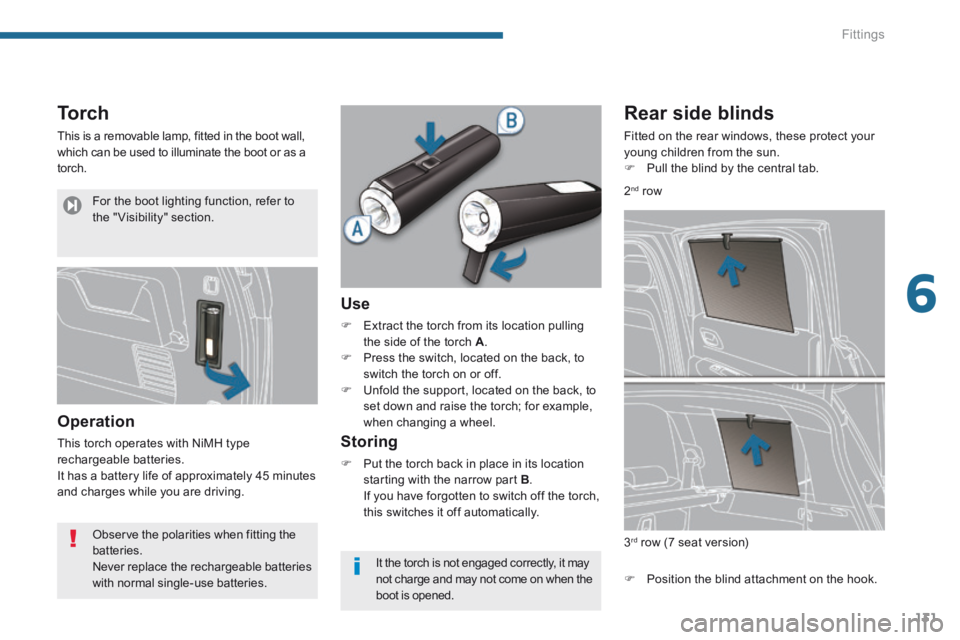Page 95 of 404

4
Access93
Emergency control
System allowing the doors to be locked and unlocked manually in the event of a malfunction of the central locking system or battery failure.
Locking the front and rear passenger doors
Locking the driver's door
Insert the key in the door lock, then turn it to the rear. You can also apply the procedure described for the passenger doors.
Unlocking the driver's door
Insert the key in the door lock, then turn it to the front.
Unlocking the front and rear passenger doors
Pull the interior door opening control.
Automatic locking
Above 6 mph (10 km/h), the doors and boot lock automatically. If one of the doors is open, the automatic central locking does not take place. If the boot is open, the automatic central locking of the doors is active.
Deactivation
Press this button again for more than two seconds.
Unlocking
Above 6 mph (10 km/h), press this button to unlock the doors and boot temporarily.
In the event of an impact, the doors unlock automatically.
Open the doors. On the rear doors, check that the child lock is not on (see the corresponding section). Remove the black cap, located on the edge of the door, using the key. Insert the key in the socket without forcing it, then without turning it, move the latch sideways towards the inside of the door. Remove the key and refit the cap. Close the doors and check that the vehicle has locked correctly from the outside.
A confirmation message is displayed, accompanied by an audible signal.
Page 97 of 404
4
Access95
Tailgate release
Unlocking
Fold back the rear seats to gain access to the lock from inside the boot. Insert a small screwdriver into hole A of the lock to unlock the tailgate. Move the latch to the left.
Locking after closing
If the fault persists after closing again, the boot will remain locked. System allowing the mechanical unlocking of the boot in the event of a battery or central locking system malfunction.
Page 105 of 404

5
Visibility103
Switching off the lighting when switching off the ignition
When the ignition is switched off, all of the lamps switch off immediately, except for the dipped beam headlamps if automatic guide-me-home lighting is activated.
In good or rainy weather, by both day and night, the front foglamps and the rear foglamps are prohibited. In these situations, the power of their beams may dazzle other drivers. They should
only be used in fog or falling snow. In these weather conditions, you should switch on the foglamps and dipped beam headlamps manually, as the sunshine sensor may detect sufficient light. Do not forget to switch off the front and rear foglamps when they are no longer necessary.
Switching on the lighting when switching on the ignition
To reactivate the lighting control stalk, turn the ring A to position "0" - lighting off, then to the position of your choice.
If the lighting is switched on manually after switching off the ignition, there is an audible signal when a front door is opened to warn the driver that they have forgotten to switch off the vehicle's lighting, with the ignition off. They switch off automatically after a period which depends on the state of charge of the battery (entry to energy economy mode).
Page 118 of 404

Visibility
116
This comes on automatically when the boot is opened and switches off automatically when the boot is closed.
Boot lamp
To r c h
Portable lamp, fitted in the boot wall, which can be used to light the boot or as a torch.
Operation
Once engaged firmly in its location, it comes on automatically when the boot is opened and switches off automatically when the boot is closed. It operates with NiMH type rechargeable batteries. It has a battery life of approximately 45 minutes and recharges while you are driving.
Footwell lighting
Activation
The soft lighting provided by the footwell lamps improves visibility in the vehicle when the light is poor.
Different lighting times are available: - when the ignition is off, approximately ten minutes, - in energy economy mode,
approximately thirty seconds, - when the engine is running, no limit.
For the torch function, refer to the "Fittings" section.
Observe the polarities when fitting the rechargeable batteries. Never replace the rechargeable batteries with normal single-use batteries.
Its operation is identical to that of the courtesy lamps. The lighting comes on when one of the doors is opened.
Page 133 of 404

6
Fittings131
Torch
This is a removable lamp, fitted in the boot wall, which can be used to illuminate the boot or as a torch.
Operation
This torch operates with NiMH type rechargeable batteries. It has a battery life of approximately 45 minutes and charges while you are driving.
Use
Extract the torch from its location pulling the side of the torch A . Press the switch, located on the back, to switch the torch on or off. Unfold the support, located on the back, to set down and raise the torch; for example, when changing a wheel.
Storing
Put the torch back in place in its location starting with the narrow part B . If you have forgotten to switch off the torch, this switches it off automatically.
Rear side blinds
Fitted on the rear windows, these protect your young children from the sun. Pull the blind by the central tab.
Position the blind attachment on the hook.
3 rd row (7 seat version)
2nd row
Observe the polarities when fitting the batteries. Never replace the rechargeable batteries with normal single-use batteries.
It the torch is not engaged correctly, it may not charge and may not come on when the
boot is opened.
For the boot lighting function, refer to the " Visibility" section.
Page 171 of 404

9
Driving169
Emergency braking
In the event of a failure of the main service brake or in an exceptional situation (e.g. driver taken ill, under instruction, etc) a continuous pull on the control lever on the control lever on the control leverA will stop the vehicle . The dynamic stability control (DSC) provides stability during emergency braking. If there is a fault with the emergency braking,
one of the following messages will be displayed: - "Parking brake faulty". - "Parking brake control faulty".
If a failure of the DSC system is signalled by the illumination of this warning lamp, then braking stability is not guaranteed. In this event, stability must be assured by the driver by repeating alternate "pull release" actions on control lever A .
Before leaving the vehicle, check that parking brake warning lamp in the instrument panel is on, not flashing.
The emergency braking must only be used in exceptional circumstances.
Particular situations
In certain situations (e.g. starting the engine), the parking brake can automatically alter its force. This is normal operation. To advance your vehicle a few centimetres without starting the engine, but with the ignition on, press on the brake pedal and release the parking brake by pulling then releasing control lever A . The full release of the parking brake is confirmed by the warning lamp in the control lever A and the warning
lamp in the instrument panel going off and the display of the message "Handbrake off ". If a parking brake fault occurs while applied or if the battery runs flat, an emergency release is always possible.
Page 174 of 404
Driving
172
SituationsConsequences
Display of the message " Parking brake control fault - auto parking brake activated " and of the following warning lamps:
- Only the automatic application on switching off the engine and automatic release on acceleration functions are available. - The manual application/release of the electric parking brake and the emergency braking are not available.
and possibly
flashing
Battery fault - If the battery warning lamp comes on you must stop immediately as soon as the traffic allows. Stop and immobilise your vehicle (if necessary, place the two chocks under the wheels). - Apply the electric parking brake before switching off the engine.
Page 196 of 404

Driving
194
Stopping the vehicle
Before switching off the engine, you can engage position P or N to place the gearbox in neutral. In both cases, apply the parking brake to immobilise the vehicle, unless it is programmed to automatic mode.
Operating fault
When the ignition is on, the lighting of this warning lamp, accompanied by an audible signal and a message in the multifunction screen, indicates a gearbox malfunction. In this case, the gearbox switches to back-up mode and is locked in 3rd gear. You may feel a substantial knock when changing from P to R and from N to R . This will not cause any damage to the gearbox. Do not exceed 60 mph (100 km/h), local speed restrictions permitting. Have it checked by a PEUGEOT dealer or a qualified workshop. This warning lamp may also come on if a door is opened.
Invalid value during manual operation
This symbol is displayed if a gear is not engaged correctly (selector between two positions).
You risk damaging the gearbox: - if you press the accelerator and brake pedals at the same time, - if you force the lever from position Pto another position when the battery is flat. To reduce fuel consumption when stationary for long periods with the engine running (traffic jam...), position the gear lever at N and apply the parking brake, unless it is programmed in automatic mode.
If the lever is not in position P , when the P , when the Pdriver's door is opened or approximately 45 seconds after the ignition is switched off, there is an audible signal and a message appears.
Return the lever to position P ; the audible signal stops and the message disappears.